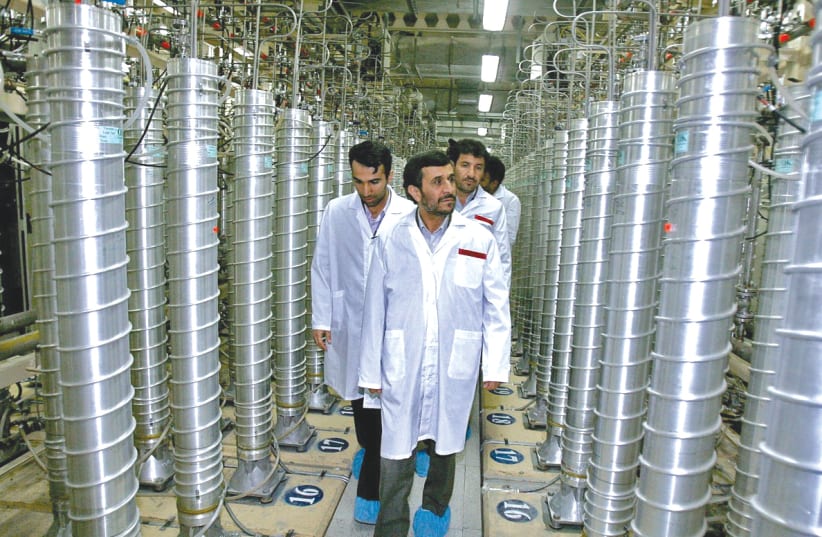There is an inconvenient truth that almost no one in Israel or the US has talked about in recent weeks: has the International Atomic Energy Agency’s loss of cameras for monitoring Iran’s uranium enrichment allowed the ayatollahs to make portions of the nuclear material disappear?
In other words, the main danger on the Iran nuclear front is not how close Tehran is to enriching enough uranium for a nuclear bomb – called the “breakout” point – but rather, that it likely has already achieved a first opportunity for a “sneak-out.”
The “sneak-out” refers to the IAEA currently being blind to much of what Iran is doing in its nuclear facilities. In other words, the Islamic Republic could be moving enriched uranium to other clandestine sites where it could secretly achieve nuclear weapons capability, even after it allows the agency’s inspectors and their cameras to return to the main facilities.
This is not to say that Iran potentially being a mere month from having sufficient weaponized uranium for a nuclear bomb is not a major issue in and of itself. Obviously, it is.
But that crisis has been hovering over the US, Israel and others since April, when Tehran jumped its uranium enrichment levels not just from 5% to 20%, but to the 60% level, considered only one level below the 90% weaponized level.
Yet until sometime in the May-July period, the IAEA had a close to constant front row seat for everything Iran was doing at its major nuclear facilities.
True, the IAEA inspections were far from perfect, lacking access to military sites and lacking anytime/anywhere surprise inspection capabilities.
However, when it came to the main uranium enrichment facilities, the IAEA inspection regime, especially its cameras, was top-notch.
Significantly, at the early and even middle stages of enriching uranium, it is not easy to make progress without large facilities, meaning it is hard to conceal progress.
This meant that IAEA cameras at the Natanz, Fordow and other facilities had uranium enrichment under a microscope of constant watchfulness.
Yet if there have always been concerns that the Islamic Republic was hiding weaponization aspects of its nuclear program in undeclared clandestine facilities, these concerns have spiked now that the IAEA is mostly flying blind.
Former prime minister Ehud Barak pointed out in a Yediot Aharonot op-ed on Monday that it is much easier to conceal the process of enriching 60% uranium up to the 90% weaponized level than it is to conceal enrichment at the lower levels.
That is because as the enrichment percentage goes up, the volume of uranium still being used is much less. This means that much fewer machines are needed for the enrichment process. Fewer machines mean smaller facilities, and make it easier to hide.
What exactly is the current status of the IAEA’s monitoring cameras?
At least three different stories have been told in the last 10 days.
IAEA Director-General Rafael Grossi announced on September 12 that some of the agency’s cameras were mysteriously broken or damaged, and some were left unattended for months beyond the standard date for them to be serviced.
Did the IAEA and the world miss something during those time periods?
Was something missed when many of the other cameras may also have had technical issues, since they were not replaced after three months as is standard, but after around seven months?
Grossi acknowledged that he had no answers, but said the main thing was that he had reestablished “communication” with Iran’s new government.
On September 13, Grossi said an incident – attributed by many to the Mossad – at Iran’s Karaj nuclear facility may have destroyed some of the IAEA’s monitoring equipment.
He did not mention who caused the incident, and it is possible that Iran used the incident to take action against IAEA equipment.
He then added that his agency does not know how much monitoring data was lost of Iran’s nuclear program as a result of its broken and damaged cameras.
“We still need to see the degree of gap” of missing data, said Grossi, explaining that he hoped the IAEA’s other monitoring redundancies would uncover any missing data.
The IAEA spokesperson did not respond to inquiries on whether its own staff had established that the June incident had caused damage to its equipment, or whether it was repeating Iran’s assessment.
In addition, the IAEA spokesperson did not address if any of its equipment was damaged during prior explosions at different nuclear facilities in the Natanz area (also attributed by Iran and others to the Mossad) in July 2020 and in April.
Despite Grossi’s talk of a deal for IAEA inspectors to replace their monitoring cameras at nuclear facilities, Fars reported on September 16 that Iran’s Atomic Energy Agency Chief Mohammad Eslami had said a large number of the cameras had been shut off.
Confusingly, Eslami seemed to distinguish between permitting certain cameras under a pre-JCPOA deal with the IAEA to continue, while deactivating additional cameras installed as part of the JCPOA.
The follow-up question is: would the IAEA know if Iran was smuggling some of its 60% enriched uranium to a clandestine site for a sneak-out to a nuclear weapon scenario?
Maybe Grossi will be able to give some reassuring answers in the coming weeks, once his inspectors receive the expected restored access to the cameras.
But this vacuum period of weeks or months might also be impossible for the IAEA to reconstruct.
If that is the case, the Mossad might need to perform yet another daring operation before the sneak-out scenario becomes a reality.

